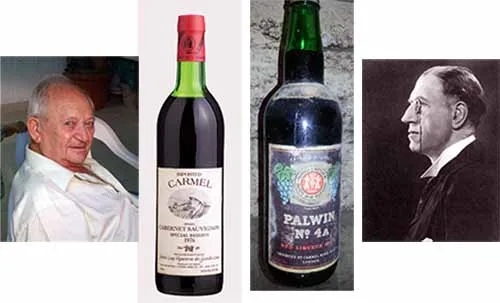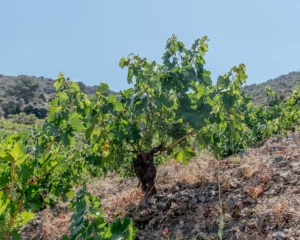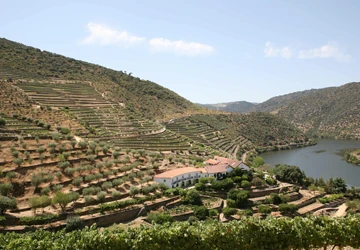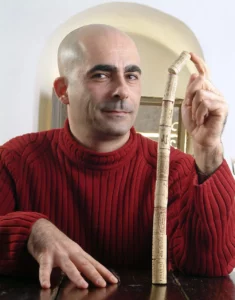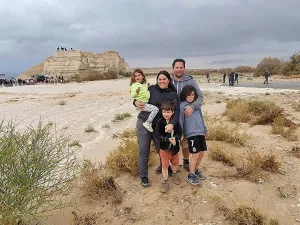Seventy years of the State of Israel and seventy years of Israeli wine. This has included thirty-five years of wine mediocrity and thirty-five years of exciting development. We went from a time when Alicante was the most planted grape variety in the 1950’s, to four decades of dominance by Carignan until today, when Cabernet Sauvignon is the most planted variety. When the State of Israel was founded over ninety percent of our vineyards were planted in the coastal regions including the valleys surrounding the southern Mount Carmel and the central plain, the Judean Plain and Judean Foothills. Now the vineyard concentration has moved northwards to the Galilee and Golan Heights and eastwards to the Judean Hills rising towards Jerusalem. I will attempt to divide our wine story into decades and select a wine and the person who contributed most.
In the 1950’s most of the wine drunk was sweet and it was only something to be imbibed with a religious connotation. Funnily enough the love of sweet was not unique to our Jewish world. In the Australia and California of the same time, people also drunk sweet wine and inexpensive fortified wines.
The wine that symbolizes the era for me is Palwin No. 10. Pre-state Palwin was a brand across the range. By the 1950’s it was a Kiddush wine only, and it was the largest export of the time. It was a wine originally marketed for the British by the Palestine Wine & Trading Company founded in 1898. (Hence the name.) Each wine was identified by a number. It is Israel’s oldest wine brand and reminds me of the time sweet wine was king.
An influential wine person of this era was Shimon P. Rosenthal, the winemaker of Rishon Wine Cellars, then by far the largest winery. He was German born, studied wine at Geisenheim, escaped Germany before Kristallnacht and was the figure who created the infrastructure and systems for Rishon to dominate the next fifty years of Israeli wine in terms of the production of large quantities of wine, grape juice and brandy, as well as numerous liqueurs. However my man of the decade was James Rothschild, the son of Baron Edmond de Rothschild. He had taken over the Baron’s Israeli interests and in 1957 donated Rishon Le Zion & Zichron Ya’acov Wine Cellars to Carmel Mizrahi.
The sixties were dominated by the rise of semi dry wines. Carmel Hock was the largest selling wine. This was the wine that represents the decade. Old timers may remember their parents drinking Hock as a spritzer with soda water added. Adom Atic, an off dry red wine, was the most visible Israeli wine in export markets, particularly popular in Scandinavia. Avdat Red and white were the popular dry wines. At the end of the sixties, the first ever varietals were made. These are wines named after the main grape variety. There was a dry Sauvignon Blanc, semi dry Semillon, Cabernet Sauvignon and semi dry Grenache Rosé.
Carmel Mizrahi was in its pomp and the legendary managing director was Eliacomb Ostashinsky, who bestrode the wine trade with grace and style. Then the Wine Growers Cooperative had over 70% of the market. Rishon Le Zion and Zichron Ya’acov Cellars were the only large wineries in Israel. There were two medium size wineries, Eliaz and Friedman Tnuva, and about ten small wineries including Efrat, Hacormim, Shor, Carmei Zion.
It should be remembered in those days an atmosphere of austerity ruled. There was no food and wine marketing or pretention to quality. There was no branding. Food factories like Tnuva and Carmel concentrated in production and distribution. Carmel export was with the added holy objective of enabling Jews in far off communities to make Kiddush.
The seventies contained the roots of the wine revolution. Professor Cornelius Ough of the University of California at Davis, visiting Israel, observed the apple industry on the Golan Heights, noticed the high elevation and volcanic soil. He expressed the opinion this would be good wine growing country. In 1976 the first vineyards were planted on the Golan.
Also, in 1976, Freddie Stiller, by now chief winemaker of Carmel Mizrahi, decided he wanted age his prestige red wine in small oak barrels. However, there was no budget for small oak barrels for wine. The winery was a big producer of brandy, and he was permitted to purchase limousin oak barrels for maturing the fiery spirit. In a mischievous throwing of the dice, he decided put aside some of these to age his precious wine. The result was the Carmel Cabernet Sauvignon Special Reserve 1976, which believe or not, was produced from Rishon Le Zion vineyards. This was Israel’s first international style wine aged in small oak barrels and it went on to surprise over the next twenty years. Stiller and his Special Reserve wine were the man and wine of the decade. The largest selling wine of the period was Grenache Rosé.
The 1980’s heralded the founding of the Golan Heights Winery. The mischievous, creative and dynamic CEO Shimshon Welner took on the staid, conservative wine establishment with this new quality driven winery. He decided to import expertise appointing Peter Stern, a Californian wine consultant, who simply brought New World wine technology to Israel. For the first time the decision making in the vineyard of how to prune and when to harvest, passed from grower to the winery and the series of young graduates from UC Davis that Stern brought over started making wine in the vineyard and using state of the art technology at the winery. Stern was chosen partly for his name. They assumed he was Jewish, but even though he wasn’t, he worked for 20 years as the Golan Heights Winery’s wine making consultant and then for five years at Carmel. He was the most influential figure of the eighties, because, encouraged and enabled by Welner, he ushered in the Israeli wine revolution.
The wine of the 1980’s is easy. It was Yarden Cabernet Sauvignon 1985. The 1984 won the gold medal and trophy at the IWSC in London, then an astonishing result, and then the 1985 won three gold medals, which we might sneeze at today. Then it was exciting and unheard of. The wine was deep, complex and concentrated and was then the finest Israeli wine I had tasted. The Israel wine revolution was underway.
Victor Schoenfeld became chief winemaker of the Golan Heights Winery in 1992. For over 25 years he has presided over the country’s most technologically advanced winery and has succeeded in maintaining quality over the years due to his high standards, curiosity and pursuit of excellence. The Golan Heights Winery remains the number one representative of Israeli wine in world markets. Yarden Cabernet Sauvignon is still today arguably the leading ambassador of Israeli wine.
In the 1989 when I made Aliyah, there were just seven commercial wineries: Carmel Mizrahi, Barkan, Golan Heights, Efrat, Eliaz, Carmei Zion – Askalon and Baron. Then there were also the Shor family wineries, referred to as the ‘Jerusalem wineries’ (Arza, Hacormim, Shimshon & Zion), and the monasteries (mainly Cremisan, Latroun & Dir Raffat). C’est tout.
The 1990’s was the beginning of the boutique winery revolution. This was fueled by growers turning into winemakers and hobby winemakers becoming commercial. Yonatan Tishbi was the grower pioneer founding Baron Winery in 1985. Another was Ronnie James, founder of Tzora Winery. Examples of hobby winemakers were Dr. Yair Margalit and Eli Ben Zaken who founded Margalit Winery and Domaine du Castel respectively. The person I have chosen to symbolize the 1990’s is Yair Margalit. He found the first quality boutique winery, acted as a consultant to other start up wineries, wrote winemaking education books that became professional text books worldwide, and was at the forefront of wine education at Tel Hai College and Haifa’s Technion. He symbolized the boutique wine revolution that swept Israel.
The largest selling wine was Selected Emerald Riesling. Yarden Katzrin 1990 was the first de-luxe, prestige, icon wine, but the wine that summed up the decade for me was the Margalit Cabernet Sauvignon 1993, an outstanding wine, which showed that the boutique wineries could really make world class wines.
At the turn of the century with the rise of the boutique winery, the large wineries fought back. Wineries that concentrated on liquid religion, that is Kiddush wine and grape juice, starting focusing on table wine. When I arrived in Israel, all the major wineries, except the Golan Heights Winery, produced spirits too. As the gates of import opened, this declined sharply and the focus turned to wines. Names were changed to underline a change in marketing focus. Carmel Mizrahi, Efrat, Eliaz, Askalon, Baron became Carmel Winery, Teperberg, Binyamina, Segal and Tishbi respectively. The traditional wineries Zion and Arza later opened new wineries, 1848 and Hayotzer, when they also made the quality switch.
In the 2000’s, Israeli wine first started receiving international recognition. The person who symbolized this for me was Eli Ben Zaken of Domaine du Castel. He set the standards of style and quality in Israel and he was the pioneer of the Judean Hills. In addition, the family twice built the most beautiful winery in Israel!
One of the most significant wines of the decade was the Castel Grand Vin 2003, the first complete vintage after the winery turned kosher. The K word was a big obstacle for the non-Jewish wine world to absorb, but when Castel turned kosher and their international ratings improved, it proved kashrut was no bar to quality. However, my choice is the complex and supple Grand Vin 2006. It both received the highest score for an Israeli wine from Robert Parker’s Wine Advocate and contributed significantly to Castel becoming the first Israeli winery to get the maximum Four Stars in Hugh Johnson’s Pocket Wine Book. As Parker & Johnson are respectively the most important wine critic and wine writer in the world, it was important third party recognition for Israel, at the very highest possible level. The largest selling wine in the early 2000’s was Yarden Mount Hermon Red, which symbolized the move in the market to red wines. Israel changed from a white wine drinking culture to red wines. Gato Negro from Chile was the biggest import.
We are now in the 2010’s. The person symbolizing this current decade is Eran Pick MW, the winemaker of Tzora Vineyards. He became Israel’s first ever Master of Wine, which has already helped to further open the door for Israeli wines in the world. He is leading what is the next revolution in Israeli wine, the search for Israeli identity and the desire to express terroir.
As for the wine of the decade, it is still early days, and I don’t have the luxury of hindsight, but I choose the Tzora Shoresh Blanc 2013, because it symbolizes this search and for me represents the extraordinary advances Israel has made in making white wines in recent years. It was minerally and characterful and it was certainly a revelation that Israel could produce white wines of this intensity. The largest selling wine is still Hermon Red. It is same wine but now without the brand name Yarden on the label, and the largest selling imported wine is Blue Nun, a phenomenon in Israel.
I focused on one person per decade, but there are others that merit a mention. If I was putting forward names for the Israel Prize for Wines, these people would have to be considered too. Segev Yerovam was the CEO of the Golan Heights Winery in the 1990’s. He set the standards for winery management in terms of pursuit of quality in vineyard and winery, marketing with style, quality and aesthetics, success through people and the organizing of original winery events. Then there is Uri Shaked, who brought international standard retailing to Israel with the founding of his Derech Ha’yayin wine store chain. He still bestrides the wine trade like a colossus as an importer, distributor, retailer and winery owner. The late Daniel Rogov, was my predecessor as wine writer for the Jerusalem Post and later became wine critic of Haaretz, and author of Rogov’s Guide to Israeli wines. He became the voice of the Israeli wine renaissance, and his passing has left a void. He has never really been replaced. As far as sommeliers go, one who reached the top in his craft, and now puts something back, is Avi Ben Ami of Studio Ben Ami who organizes the competitions Best Value and Eshkol Hazahav as well as the Sommelier Trade Show.
Exports of Israeli wine have risen impressively. At the beginning of the 2000’s export was about 8 million dollars, today it is 50 million dollars. Credit should go to the Israel Export Institute which is the only body to advance Israeli wine. The Israel Wine and Grapes Board and Wine Institute have been incapable of organizing any marketing initiatives to advance Brand Israel, lacking finance, authority and ambition. However, the Export Institute has organized exhibitions and tasting events abroad and brought wine writers and buyers to Israel. The first organized visit of Masters of Wine is an example. It is a first and is organized by the Israel Export Institute. Without them, it would not have happened.
Israeli wine has received 94 points in Robert Parker’s Wine Advocate, four stars in Hugh Johnson’s Pocket Wine Book and a cover story in the Wine Spectator. Wine represents modern Israel, the land and the people, and also connects us by a thread to Ancient Israel, Biblical times and the roots of the Jewish people, when wine was important culturally and then it was the basis of the economy. The growers and viticulturists who care for the vineyards, winemakers and wineries, who make the wines and sommeliers, restaurateurs and wine retailers, who showcase and sell Israeli wines, should take a bow! We have made incredible advances over seventy years. It is not to say we are challenging any major wine producing country. France & Italy are not quaking in their boots. We don’t want to overstate our case, but if you consider where we were 35 years ago, and where we might be in another 35 years, that is impressive. The exciting journey continues.
Adam Montefiore has advanced Israeli wine for over 30 years and he is referred to as ‘the ambassador of Israeli wine.’ He is the wine writer for the Jerusalem Post and writes a regular column called ‘Wine Talk.’ www.adammontefiore.com


